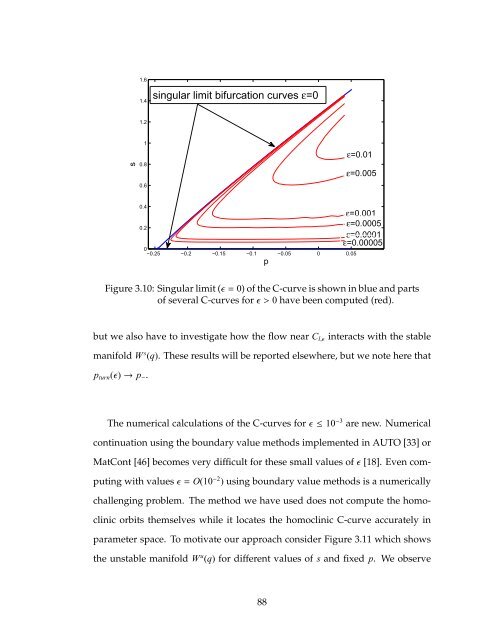multiple time scale dynamics with two fast variables and one slow ...
multiple time scale dynamics with two fast variables and one slow ...
multiple time scale dynamics with two fast variables and one slow ...
You also want an ePaper? Increase the reach of your titles
YUMPU automatically turns print PDFs into web optimized ePapers that Google loves.
s<br />
1.6<br />
1.4<br />
1.2<br />
1<br />
0.8<br />
0.6<br />
0.4<br />
0.2<br />
singular limit bifurcation curves ε=0<br />
0<br />
−0.25 −0.2 −0.15 −0.1 −0.05 0 0.05<br />
p<br />
ε=0.01<br />
ε=0.005<br />
ε=0.001<br />
ε=0.0005<br />
ε=0.0001<br />
ε=0.00005<br />
Figure 3.10: Singular limit (ǫ= 0) of the C-curve is shown in blue <strong>and</strong> parts<br />
of several C-curves forǫ> 0 have been computed (red).<br />
but we also have to investigate how the flow near Cl,ǫ interacts <strong>with</strong> the stable<br />
manifold W s (q). These results will be reported elsewhere, but we note here that<br />
pturn(ǫ)→ p−.<br />
The numerical calculations of the C-curves forǫ≤ 10 −3 are new. Numerical<br />
continuation using the boundary value methods implemented in AUTO [33] or<br />
MatCont [46] becomes very difficult for these small values ofǫ [18]. Even com-<br />
puting <strong>with</strong> valuesǫ= O(10 −2 ) using boundary value methods is a numerically<br />
challenging problem. The method we have used does not compute the homo-<br />
clinic orbits themselves while it locates the homoclinic C-curve accurately in<br />
parameter space. To motivate our approach consider Figure 3.11 which shows<br />
the unstable manifold W u (q) for different values of s <strong>and</strong> fixed p. We observe<br />
88
















